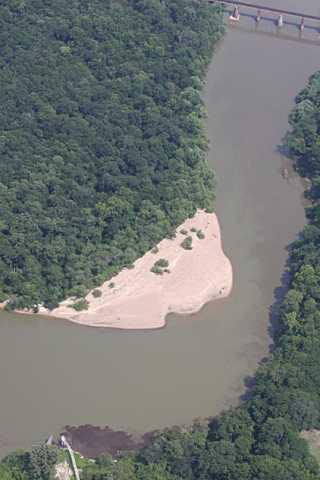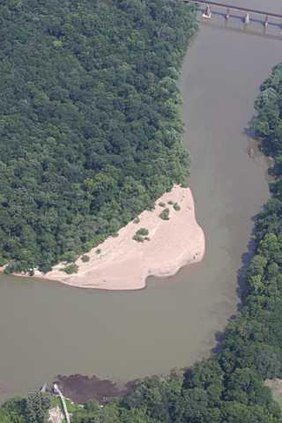The ‘Dirty Dozen’
1. Ogeechee River
2. Altamaha River
3. Savannah River
4. Chattahoochee River
5. Shoal Creek and Flat Creek
6. Oconee and Ogeechee rivers
7. Flint River
8. Coastal Wetlands
9. South Georgia Wetlands
10. Broad River
11. Brier and Commissioner creeks
12. Coosa River
Source: Georgia Water Coalition
With its annual "Dirty Dozen" rivers list, the Georgia Water Coalition aims to send a wake-up call to state residents before their fresh waters are overtaken by human waste, dredging and neglect.
Though no rivers within Liberty County made appearances, the Savannah, Ogeechee and Altamaha rivers topped the 2011 list, which the consortium of more than 180 conservation and environmental organizations released Nov. 5.
"It was no surprise that the Ogeechee made the list because we had the biggest fish kill in Georgia history," Ogeechee Riverkeeper Dianna Wedincamp said. "What I like about the ‘Dirty Dozen’ is it gives us a little bit more help getting the word out about how many offenses are happening to Georgia’s waters and how the state is underfunded and cannot do their job to protect the rivers in Georgia."
The Ogeechee River came in at No. 1 on the list. The coalition cited five years of King America Finishing Co. discharges into the Ogeechee without state knowledge or approval. In May, an estimated 33,000 fish perished due to a bacterial disease caused by environmental distress as a result of the textile company’s discharge.
Though the river was restocked in October, the riverkeepers assert the Environmental Protection Division has not done enough to prevent or undo the damage.
Wedincamp blames a lack of political will to enforce the laws and protect communities whose livelihoods depend on the rivers.
"I just think the whole system is broken, and we need to make some aggressive changes within the government to address these issues," she said, challenging citizens to speak up to their state and local representatives and demand change in leadership, even on the state’s appointed Department of Natural Resources board.
The report named the Altamaha No. 2 on the list due to long-term discharge from Jesup’s Rayonier pulp mill. It claims the river’s white sandbars have turned brown due to pulpy outputs, and fishermen bring home fish that reek of pulp mill odors.
Deborah Sheppard, executive director of the Altamaha Riverkeeper, said she was glad to have the report draw attention to the problem but that it’s disappointing that it persists after 11 years of efforts to effect change.
"The list shows a real need for the people in Georgia to get behind funding and encouragement to make sure that the Georgia EPD starts to enforce laws that affect our water quality," Sheppard said. "Clean water for people and our families is key to our future."
Sheppard described seeing a thick, chocolate-colored film that inundates the river at the company’s output. The color prevents photosynthesis and natural biological functions, effectively disrupting the river’s chemical balance, she said.
The effluent and its smell also have inhibited locals from enjoying the river for recreation and fishing, Sheppard said.
"It’s a sickening smell. People have asked me to try and describe it … it’s a very particular stinky paper effluent smell," she said, adding that people have told her they can smell it all the way to Darien.
But Rayonier spokeswoman Robin Keegan said that the information in the report is not completely accurate.
"There’s no pulp discharged into the river," she said. "The (dark) color that they’re talking about there is the result of the natural wood … that’s the result of the natural tannins."
The company has its own conservation efforts, which include placing 14,000 acres in the river’s basin into conservation and working under a voluntary EPD consent order, Keegan said. Since 2008, Rayonier has reduced its color output by 29 percent and will spend $38 million in the next four years to continue the reduction.
"If they’ve spent millions of dollars over the past four years, it’s not apparent from the field observations," Sheppard said.
In 2011, Rayonier worked with the EPD to change some conditions of the consent order, but Keegan said the target standards and deadlines did not change, but rather the technology used to meet them.
"Rayonier has a strong presence in Southeast Georgia. We have a lot of land in the area. We have a lot of employees in that area," Keegan said. "Again, we understand and we agree that the Altamaha River is an important waterway."
The report also cites harbor-deepening projects on the Savannah River as the No. 3 threat. In the past century, two-thirds of the 12,000 tidal freshwater wetlands in the Savannah River National Wildlife Refuge have been destroyed.
The report lambasts a current dredging effort supported by the Georgia Ports Authority, the EPD and even local entities such as the Liberty County Development Authority and calls for an Army Corps of Engineers analysis of all port expansions.
The expansion is expected to destroy another 20 percent of the remaining refuge wetlands, place several species of fish in jeopardy and increase the cost of clean drinking water in Savannah, the report said. Those who support the expansion say it will boost the region’s imports and exports, lure new manufacturers and industrial plants and ultimately create more jobs.
The Courier placed several calls to the EPD for comment, but they were not returned by press time.




